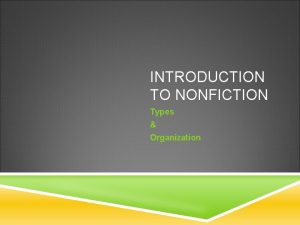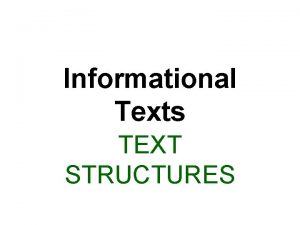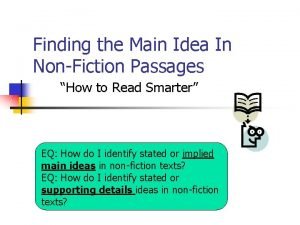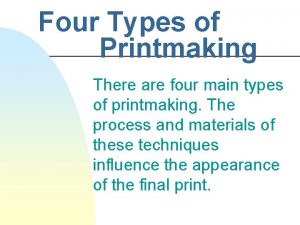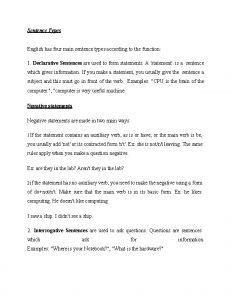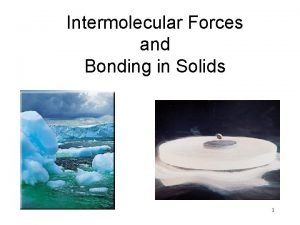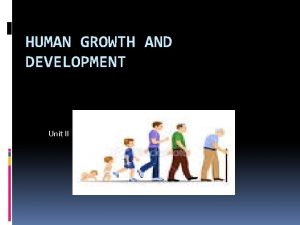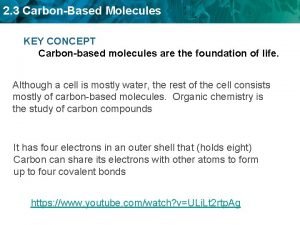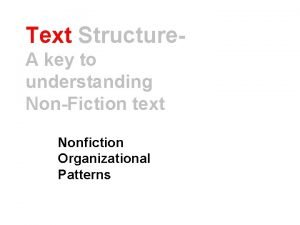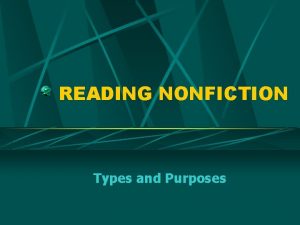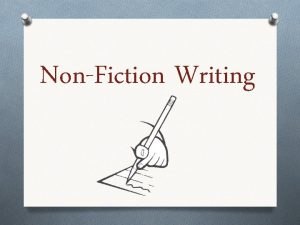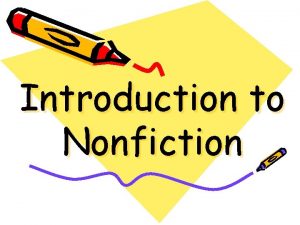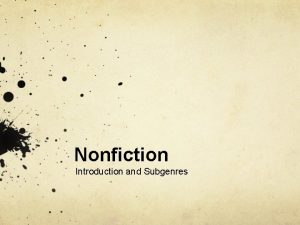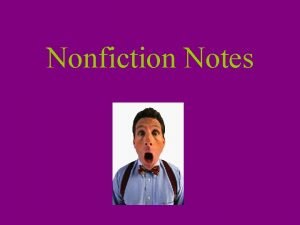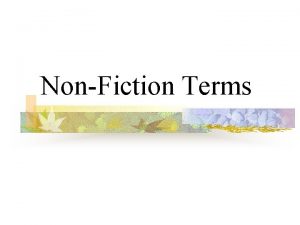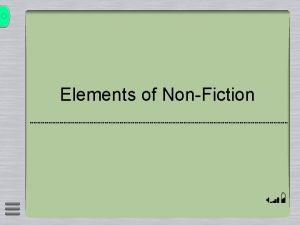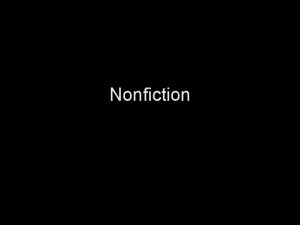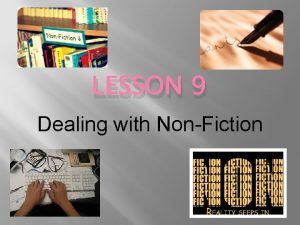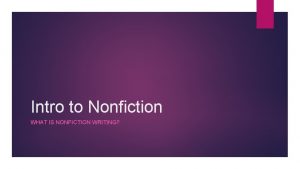INTRODUCTION TO NONFICTION Types Organization FOUR MAIN TYPES

















- Slides: 17

INTRODUCTION TO NONFICTION Types & Organization

FOUR MAIN TYPES OF NONFICTION IN OUR 8 TH GRADE STANDARDS Narrative Expository Persuasive Reflective

NARRATIVE This is most commonly seen in biographies and autobiographies. The writing tells a true story. It can include a plot, with many events that took place. The characters are real-life and deal with conflict.

INTERACT! Everyone STAND UP! Turn to the person behind you (back rows, look to the person next to you in the back rows). Each share ONE FACT about nonfiction narrative writing. GOOOO!!!!!!!!!!!!!!

EXPOSITORY This gives information about a topic. Think about how chocolate is made, where animals live, the planets, etc. Newspapers, magazines, directions, encyclopedia entries are all examples. Expository = Explain.

INTERACT! Students with last names beginning A- H, come up to the front of the room. Think of the last thing you read that would fit into the category of Expository Nonfiction. Go find someone sitting, and share it with them. GOOOOO!!!!!!!

PERSUASIVE This writing is to convince someone to see things your way. Facts and opinions will be used to support the author’s point. Advertisements, speeches, and letters to the editors are all great examples of persuasive writing.

REFLECTIVE This writing shows the author is thinking about ideas or experiences. Letters, journals, diaries, and memoirs are examples of reflective writing.

INTERACT! GIRLS- STAND UP! THINK OF AN EXAMPLE OF PERSUASIVE WRITING- BE SPECIFIC! BOYS- STAND UP! THINK OF AN EXAMPLE OF REFLECTIVE WRITING- BE SPECIFIC! RAISE YOU HAND WHEN YOU HAVE AN EXAMPLE TO SHARE. I’LL TAKE THE 1 ST 4 FROM EACH GROUP. ALL EXAMPLES MUST BE DIFFERENT

ORGANIZING NONFICTION Nonfiction is organized, or written, in many ways. There are three that are the most common: 1. Chronological Order 2. Cause & Effect 3. Compare & Contrast

CHRONOLOGICAL ORDER The writing is done in the order in which the events occur. This pattern is marked by such transitions as next, then, the following morning, a few hours later, still later, that day, by noon, when she was seventeen, before the sun rose, that month.

EXAMPLE It seemed like an ordinary day when she got up that morning, but Lynda was about to embark on the worst day of her life. First, she fell in the bathtub because her mother forgot to rinse out the bath oil. Then she spilled orange juice on the outfit she had spent hours putting together for school pictures. When she changed, she messed up the French braid her mother had put in her hair. As she walked out the door, she dropped all of her school books and her math homework flew away. Once she made it to the car she thought everything would be all right. She was wrong; her father didn't look before he backed out of the driveway and ran into the neighbor’s truck. Lynda’s side of the car was damaged the most, and she ended up with a broken arm. That night, she cried herself to sleep.

CAUSE & EFFECT This writing shows how one event will lead to another event. Commonly used transitions for this type of writing are as follows: * For causes- because, due to, on cause is, another is, since, for, first, second. * For Effects- consequently, as a result, thus, resulted in, one result is, another is, therefore.

EXAMPLE Because toys have become electronic devices, some children today are unable to entertain themselves. Gone are the days when children invented their own adventures and used sticks as swords. cookie sheets as armor, and refrigerator box as a fortress to defend. The electronic age has delivered children all sorts of gadgets and gizmos that are supposed to be realistic. Some toys even have buttons to push so prerecorded messages can be played to begin scripted adventures that require no imagination. No imagination? No wonder some children today have short attention spans.

INTERACT! All students need to stand up. Listen to the examples read by Mrs. Roche’ IF it is chronological order, clap your hands! IF it is cause & effect, stomp your feet!

COMPARE & CONTRAST This is writing is used to show things are the same and different. Popular transitions used in this type of writing are: contrast, by the same token, conversely, instead, like-wise, on one hand, on the other hand, on the contrary, rather, similarly, yet, but, however, still, nevertheless, in contrast.

EXAMPLE As a child, I thought my parents were ignorant and out of touch with reality. They couldn’t possibly understand anything I thought or felt. When they weren’t annoying me with their ridiculous lectures, or grounding me for minor infractions of the rules, they were embarrassing me in public. Similarly, I find it frustrating that my children think I have no clue about their lives, even though I understand perfectly well what they are thinking or feeling. I find myself giving my children the same lectures I once thought were ridiculous. However, my children can not seem to follow the rules their father and I have set, and they are continuously embarrassing me in public. My, how things have changed.
 4 types of nonfiction
4 types of nonfiction Text _____ in a nonfiction text is its organization.
Text _____ in a nonfiction text is its organization. Point and read
Point and read What are the different types of printmaking
What are the different types of printmaking Four main sentence types
Four main sentence types What is folktales
What is folktales Solid
Solid Four main types of growth and development
Four main types of growth and development Four main types of carbon based molecules
Four main types of carbon based molecules Types of nonfiction text structure
Types of nonfiction text structure Types of nonfiction books
Types of nonfiction books Types of nonfiction prose
Types of nonfiction prose Types of nonfiction
Types of nonfiction Process organization in computer organization
Process organization in computer organization Block essay
Block essay Four levels of organization
Four levels of organization The will future
The will future Finding the main idea why were canals built?
Finding the main idea why were canals built?
